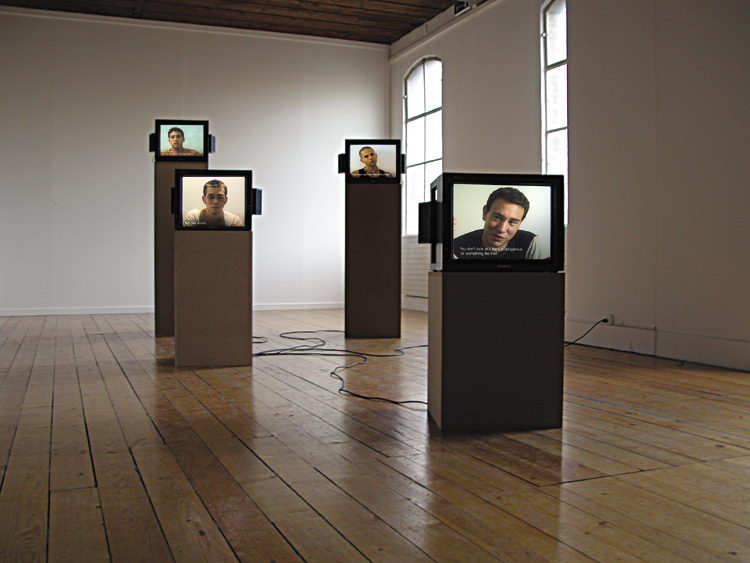Serious Games 3, Immersion
2009 - Film & Video (Film & Video)
20 min
Harun Farocki
For Immersion , Harun Farocki went to visit a research centre near Seattle specialized in the development of virtual realities and computer simulations. One of their projects consists in using virtual reality (environments created to simulate this world) for therapeutic reasons for soldiers suffering traumas after the Iraq war. The double projection creates a parallel between animations and testimonies by soldiers reliving their mission, the explosions, gunshots and ambushes, their fears and their guilt. The chosen direct rendering and simplicity of the edit places us like the voyeur of a personal and difficult experience. The end is disconcerting since the last soldier, who one minute had been pleading his therapist to stop the program, looks at his audience and smiles with a detachment that sheds doubt on the authenticity of his account. The Virtual Iraq program is closer to a virtual game than a therapeutic program. Immersion continues to explore the impact of new technologies on society, the relations between virtual reality and the military world and how the scenarios developed as video games are used as training tools as much as a therapy. ( Read Artslant )
In the 1970s and 80s, the feature films Harun Farocki made contributed to theorizing essay-films, a cinema genre that juxtaposes archival images of different sources (news, film industry) with voiceover commentaries. More specifically it is a critical and political approach to the image that has characterized his oeuvre since the start, a point of view on the connections between war, technology and capitalism. In 1969, he makes one of his first films in 16mm called Inextinguishable Fire in which he appears as a TV presenter reading out the testimony of a Vietnamese victim of a Napalm attack. The subsequent images are like an educational documentary, an austere thesis on the origins of napalm production and the involvement of workers, students and engineers in what was largely used as a weapon against civilians. Years later, for the trilogy Eye/Machine (2001-2003), Farocki collects sequences filmed during the Gulf War, like images from projectiles, juxtaposed with images produced by machines made for surveillance, recognition and localization. The art historian Hal Foster describes Farocki’s work like a genealogy of ‘visual instrumentalization’ following the evolution of image technologies and their roles in power struggles and the exercise of control. At the beginning of the 1990s he begins to imagine double projections that were presented in cinemas and soon in galleries and institutions that could easily adapt to this mode of projection. The evolution of the forms of presentation and distribution of his work explains his presence in various economies and most recently that of the art market. Harun Farocki was born in 1944 in Neutitschein, Czech Republic. He lived and worked in Berlin where he passed away in 2014.
Colors:
Related works of genres: » 1944–2014, » contemporary artist, » filmmaker
» see more

© » KADIST
Tacita Dean
2001The photographic quality of the film Baobab is not only the result of a highly sophisticated use of black and white and light, but also of the way in which each tree is characterized as an individual, creating in the end a series of portraits...

© » KADIST
Laure Prouvost
2018Monteverdi Ici by Laure Prouvost is a non-narrative video work that depicts the back of the artist’s naked body standing, with her back towards the camera in a field...

© » KADIST
Jonathan Monk
2003Untitled (rolled up) , is an abstract portrait of Owen Monk, the artist’s father and features an aluminum ring of 56.6 cm in diameter measuring 1.77 cm in circumference, the size of his father...
Related works sharing similar palette
» see more

© » KADIST
Yee I-Lann
20207-headed Lalandau Hat by Yee I-Lann is an intricately woven sculpture evoking the ceremonial headdress worn by Murut men in Borneo...

© » ARTS EQUATOR
Quiz: What's Your Guilty Pleasure? | ArtsEquator Thinking and Talking about Arts and Culture in Southeast Asia ArtsEquator Viewpoints Kristina Flour via Unsplash November 11, 2021 It’s 2021 – and you’re constantly being told to be your best self! There’s that pile of books waiting to be read, countless browser tabs open with must-read articles, and a list of podcasts that are supposed to make you smarter...

© » KADIST
Leslie Shows
Human Quarry is a large work on paper by Leslie Shows made of a combination of acrylic paint and collage...
Related artist(s) to: Harun Farocki » Hito Steyerl, » Joachim Koester, » Allan Sekula, » Jimmie Durham, » Rabih Mroué, » Andrei Ujica, » Angela Melitopoulos, » Anri Sala, » Anselm Franke, » Antje Ehmann
» see more
© » KADIST
Rabih Mroué
2012The Pixelated Revolution is a lecture-performance by artist Rabih Mroué about the use of mobile phones during the Syrian revolution...

© » KADIST
Joachim Koester
2007Tarantism is the name of disease which appeared in southern Italy, resulting from the bite of a spider called Tarantula...
Related works found in the same semantic group
» see more

© » LONDONIST
Shifting Landscapes At Oxo Tower Wharf | Londonist A Free Exhibition Featuring Virtual Rainforests Is Coming To Oxo Tower Wharf By Hannah Newlon-Trujillo Hannah Newlon-Trujillo A Free Exhibition Featuring Virtual Rainforests Is Coming To Oxo Tower Wharf Sanctuaries of Silence, a virtual reality experience by Adam Loften and Emmanuel Vaughan-Lee...

© » KADIST
Pavel Wolberg
2004A young settler girl, dressed in a bridal outfit for Purim, stands in a street in Hebron waiting, perhaps for her parents or other children to join her...






